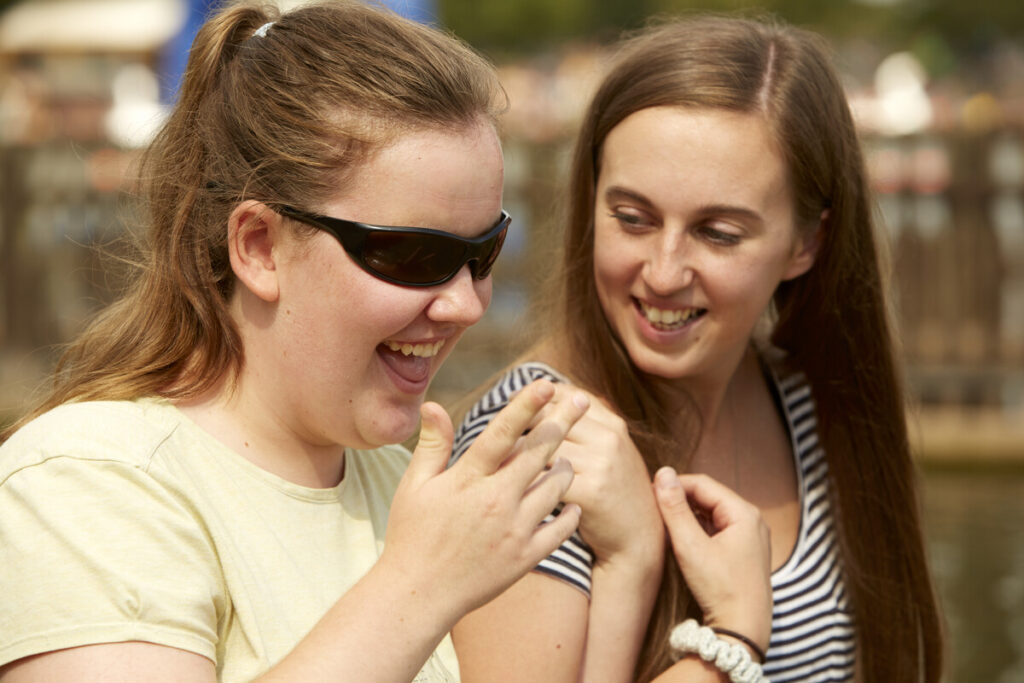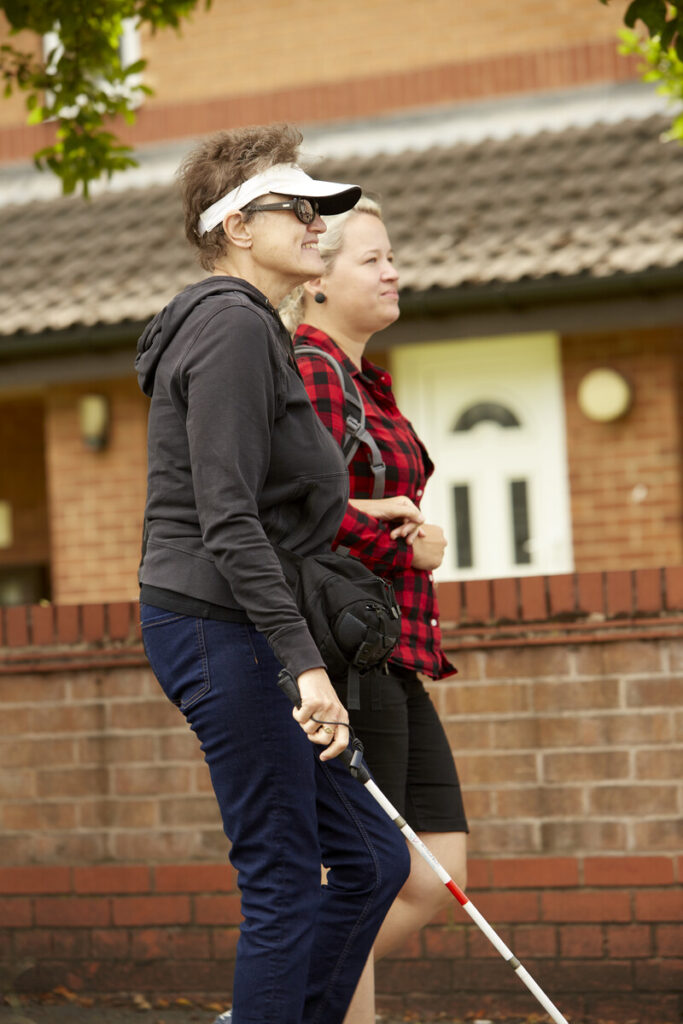How to guide someone who is blind or partially sighted

I work in the practice development team at Sense, supporting our services for people with complex disabilities. As part of my role, I train Sense employees in how to guide a visually impaired person.
Today, I’m here to share some of the top tips from that training with you. If you’ve never offered your support to a blind or partially sighted person before, this blog is for you!
Why is this important? Because good guiding gives the person who is being guided the confidence to explore and make choices in their environment.
As my colleague Zoe explains:

“As a registered severely sight impaired person, it’s imperative that I am sight guided to be able to lead an independent life. I do use mobility aids, such as a long cane and guide dog, but a sight guider provides me with more independence and a better understanding of the environment I’m in. Without this support, I would find it extremely difficult to lead a fulfilled, independent life.”
Zoe Bates
Here are my tips on what to do (and what not to do) to support a person with a visual impairment.
Don’t be afraid to offer your help
You should never presume that somebody who is blind or partially sighted needs your support. Always ask.
You might introduce yourself, and then ask, “Would you like any support with guiding?”
Some people might feel nervous about approaching somebody to ask if they want any help. Don’t be too shy – many people with visual impairments are used to being guided and will appreciate the offer.
Make the offer if it’s appropriate, and then they have the choice to take you up on it or not.
Find out the person’s preferences
If the person says yes, the next thing to do is find out how they prefer to be guided.
It might be that they would rather you be on their left or right side. This could be because of their hearing or other disabilities, or just a personal preference.
If the person is deaf or hard of hearing, you might need to use tactile communication rather than speaking to them.
This could mean wearing something that they can feel to help them identify you, like a badge or a bracelet. You should also keep touching them, on the shoulder or arm, so that they know you’re there.
Offer your arm (don’t take theirs)
The best way to guide someone is by offering them your arm, and letting them put their hand on it.
Often, they might place a hand on your shoulder, or your elbow. But every person is different.
Some people might want to link arms with you for more stability.
Whatever they choose, the important thing is that you offer your arm and let them use it. They should be in control. Don’t grab the person, and never take their hand!
Go at a steady, comfortable pace

Once you’ve set off with the person, make sure that you’re not moving too quickly.
But also, don’t be too slow, because this might make them feel anxious. Just walk at a typical pace.
If the person speaks, they might tell you if they want to go faster or slower. You can also pay attention to their body language, to see whether they are tense or relaxed. Check if your pace is okay with them.
Walk alongside a rail or wall if possible
Often, people with visual impairments who are being guided might feel more insecure on their “open” side (the side you’re not on).
If there’s a wall, fence or a railing that they can trail along, this can be helpful to orientate them. It gives them a bit more information.
Be aware of your surroundings
When you’re guiding somebody who is visually impaired, you need to be fully aware of the space around you both.
Remember that you need space for two people, not one! (If you’re passing through a narrow space, you can slightly move in front of the person you’re guiding, and let them hold onto you from behind.)
Keep looking out for anything that might be a hazard, like postboxes, lamp posts or kerbs. That includes things that hang down from above, like tree branches or door frames.
If there are going to be any changes to the terrain or the space, let the person know what to expect. You could also pause briefly to let them process this information, and give them time to prepare for what’s next.
Give the person information about the environment
When sighted people enter a room, we take in a lot of visual information very quickly, but visually impaired people don’t have access to all that.
Tell the person that you’re guiding what is happening around them. Is it busy? If you enter a room, who is in there? Where are the nearest toilets, or drink points?
Just pick out a few key details. Saying too much can be overwhelming.
“When sighted people enter a room, we take in a lot of visual information very quickly, but visually impaired people don’t have access to all that. Tell the person that you’re guiding what is happening around them.”
If the person you’re guiding is deafblind, they might need to touch things to understand what’s around them. Trailing (running their hands along a wall or another surface) is good for that.
You might also guide them to touch things in the room, by letting them lightly rest their hand on top of yours as you touch things. This is known as a hand-under-hand technique.
It could be quite scary if your hands are just being taken and placed onto things when you don’t know what they are – so it’s more respectful to let someone simply follow your hand.
Take the lead when it comes to stairs or doors
If you reach some stairs, you should pause before the first step, and let the person know how many there are.
Take the first step, and let the person you’re guiding follow you. Make sure they’re on the handrail side.
When you’re near the top or bottom of the stairs, let the person know by saying something like “Almost there”, or “One more step”.
Similarly, when you’re going through a door, you should tell the person that you’re going through a door, and lead the way.
Make sure the person you’re guiding is on the hinge side, and you go through the door first. This way, you can be aware if there’s any hazards on the other side of the door.
They can then feel their way along the door and close it themselves.
Never push the person you’re guiding into a chair
If you’re guiding someone to a chair, you should never bring it up behind them or push them into it.
Instead, when you arrive at the chair, gently guide their hands to the back and the seat using the hand-under-hand technique. You should also explain what type of chair it is (for example, does it swivel? Does it have arm rests?).
The person can then sit down independently.
You might want to let the person know if they’re sitting at a table, and if there are other people at the table, or objects in front of them. Information like this can help people to feel more confident.
Let them know you’re finished
When you’re finished guiding somebody, don’t just wander off! Let them know that you’re leaving.
You can also let them know if there are other people with them, and – if it’s appropriate – how they can find you again if they need more help.
You might say something like, “Is it okay if I leave you here? I’ll be on the other side of the room if you need any more support.”
Get support from Sense
We offer support for people with complex disabilities all over the UK.

